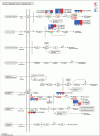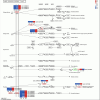Integrated transcriptomics and proteomics revealed that exogenous spermidine modulated signal transduction and carbohydrate metabolic pathways to enhance heat tolerance of lettuce
- PMID: 40468188
- PMCID: PMC12135235
- DOI: 10.1186/s12870-025-06781-7
Integrated transcriptomics and proteomics revealed that exogenous spermidine modulated signal transduction and carbohydrate metabolic pathways to enhance heat tolerance of lettuce
Abstract
Lettuce (Lactuca sativa L.) is sensitive to high temperatures, and the growth is inhibited under excessive temperature. Spermidine can improve the ability of lettuce to tolerate high temperatures, however, the molecular mechanism was poorly understood. The molecular mechanism of lettuce response to heat stress (2h) were investigated by physiology, transcriptome, and proteome. The results showed that 781 differentially expressed genes (DEGs) and 255 differentially expressed proteins (DEPs) were detected in lettuce treated with spermidine under heat stress. The DEGs and DEPs of lettuce were treated with 1 mM spermidine under high temperatures stress. There were 718/236 genes/proteins with the same expression trend. Kyoto Encyclopedia of Genes and Genomes (KEGG) enrichment analysis revealed the genes were mainly enriched in intracellular signal transduction and carbohydrate metabolism pathways, which stimulated the expression of genes/proteins related to hormone and mitogen-activated protein kinase (MAPK) signal transduction pathways, starch and sucrose metabolism, pentose and glucose mutual transformation pathways. It also increased the contents of auxin and cytokinin, starch and soluble sugar. String network analysis showed that spermidine promoted material transport and antioxidant enzyme activity to improve lettuce resist high-temperature stress by removing superoxide radicals, binding and central transport of nuclear pores. In summary, signal transduction and gluconeogenic pathways may be the main ways in which spermidine improve lettuce to tolerate in heat stress. These results increase the understanding of the heat tolerance of lettuce at the transcriptional and protein levels, and provide a better understanding of the heat tolerance mechanism of lettuce.
Keywords: Exogenous spermidine; Heat stress; Lettuce; Proteome; Transcriptome.
© 2025. The Author(s).
Conflict of interest statement
Declarations. Ethics approval and consent to participate: The plant materials used in this study were provided by Beijing University of Agriculture. The methods involved in this study were carried out in compliance with local and national regulations. Consent for publication: Not applicable. Competing interests: The authors declare no competing interests.
Figures





 , indirect effect;
, indirect effect;
 , activation;
, activation;
 , inhibition;
, inhibition;
 , expression;
, expression;
 , indirect effect;
, indirect effect;
 , dissociation. In the heat map, red indicates high expression and blue indicates low expression
, dissociation. In the heat map, red indicates high expression and blue indicates low expression

 ,indirect effect;
,indirect effect;
 ,activation;
,activation;
 , inhibition;
, inhibition;
 , expression;
, expression;
 , indirect effect;
, indirect effect;
 ,dissociation. In the heat map, red indicates high expression and blue indicates low expression
,dissociation. In the heat map, red indicates high expression and blue indicates low expression




References
-
- Kotak S, Larkindale J, Lee U, von Koskull-Döring P, Vierling E, Scharf KD. Complexity of the heat stress response in plants. Curr Opin Plant Biol. 2007;10(3):310–6. - PubMed
-
- Altieri AM, Nicholls IC. The adaptation and mitigation potential of traditional agriculture in a changing climate. Clim Change. 2017;140(1):33–45.
MeSH terms
Substances
Grants and funding
- 20250107/Beijing Agricultural Science and Technology Project for Rural Revitalization
- 20250107/Beijing Agricultural Science and Technology Project for Rural Revitalization
- 20250107/Beijing Agricultural Science and Technology Project for Rural Revitalization
- 20250107/Beijing Agricultural Science and Technology Project for Rural Revitalization
- 20250107/Beijing Agricultural Science and Technology Project for Rural Revitalization
- 20250107/Beijing Agricultural Science and Technology Project for Rural Revitalization
- 20250107/Beijing Agricultural Science and Technology Project for Rural Revitalization
- 20250107/Beijing Agricultural Science and Technology Project for Rural Revitalization
- BAIC01-2024/Beijing Innovation Consortium of Agriculture Research System
- BAIC01-2024/Beijing Innovation Consortium of Agriculture Research System
- BAIC01-2024/Beijing Innovation Consortium of Agriculture Research System
- BAIC01-2024/Beijing Innovation Consortium of Agriculture Research System
- BAIC01-2024/Beijing Innovation Consortium of Agriculture Research System
- BAIC01-2024/Beijing Innovation Consortium of Agriculture Research System
- BAIC01-2024/Beijing Innovation Consortium of Agriculture Research System
- BAIC01-2024/Beijing Innovation Consortium of Agriculture Research System
LinkOut - more resources
Full Text Sources

